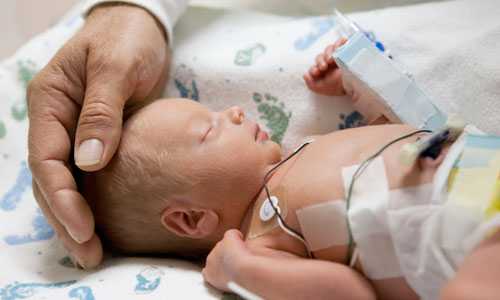Key Findings: Racial/ethnic differences in survival of children with major birth defects in the United States, 1999-2007

The Journal of Pediatrics has published a new study looking at the survival of babies with major birth defects in the United States using data from 1999-2007. The study also compared survival across racial-ethnic groups. Researchers found that for most types of birth defects, there were small to moderate differences in infant and early childhood survival between racial and ethnic groups. This study, one of the largest studies of survival among children with birth defects in the United States, provides important information for those involved in developing health policies and planning for services. For information specific to your child and your child’s prognosis, it is important to consult your healthcare provider. You can read an abstract of the article here.
Main Findings
- For most birth defects studied, survival was poorer among babies born to non-Hispanic black and Hispanic mothers, compared to babies born to non-Hispanic white mothers.
- Small to moderate differences in survival during the first 28 days of life were seen between racial/ethnic groups.
- Compared to babies born to non-Hispanic white mothers,
- survival from 28 days to 1 year of age was poorer among babies born to non-Hispanic black mothers for 13 of the 21 birth defects studied.
- survival from 28 days to 1 year of age was poorer among babies born to Hispanic mothers for 10 of the 21 birth defects.
- Children with hypoplastic left heart syndrome had the lowest chance of survival across multiple ages (up to 28 days of life, 1 year of life, 2 years of life, and 8 years), compared to children with any other birth defects studied.
- For babies born with the birth defects listed below, their chances of survival up to 1 year of life was greater than 90%:
- Future studies should examine survival among babies or children who needed surgery, those who had another condition requiring a hospital stay or other procedure, and those who had a severe or complex type of specific birth defects. Because medical care and treatment are improving, survival of babies with birth defects continues to improve over time. CDC and the National Birth Defects Prevention Network will work together to update these estimates in the future as data becomes available.
|
Survival of babies and children with selected birth defects |
||
|
Birth Defects |
Chance of survival to age 1 a |
Chance of survival to age 8 b |
|
Central Nervous System Defects |
||
|
91.9% |
90.2% |
|
|
72.1% |
69.9% |
|
|
Congenital Heart Defects |
||
|
75.1% |
71.5% |
|
|
83.7% |
81.0% |
|
|
87.1% |
84.6% |
|
|
Atrioventricular septal defect (AVSD) (without Down syndrome) |
71.0% |
67.2% |
|
83.6% |
81.5% |
|
|
55.2% |
50.4% |
|
|
84.5% |
81.8% |
|
|
Orofacial Defects |
||
|
91.0% |
90.3% |
|
|
91.6% |
90.8% |
|
|
Gastrointestinal Defects |
||
|
84.6% |
83.8% |
|
|
99.5% |
99.3% |
|
|
87.0% |
86.1% |
|
|
Musculoskeletal Defects |
||
|
89.3% |
88.2% |
|
|
88.6% |
88.2% |
|
|
68.7% |
68.0% |
|
|
92.8% |
92.1% |
|
|
71.4% |
71.2% |
|
|
Chromosomal Defects |
||
|
94.1% |
92.8% |
|
|
||
About this Study
- Researchers used data from 12 population-based birth defects tracking programs that included any of the 21 birth defects of interest. Population-based means that the researchers look at all babies with birth defects who live in a defined study area. The study covered about 39% of U.S. live births during the study period from 1999-2007.
- The study group—children with any of the 21 birth defects of interest—included 98,883 children. Participating states were Arizona, Colorado, Florida, Georgia, Illinois, Massachusetts, Michigan, Nebraska, New Jersey, New York, North Carolina, and Texas.
CDC’s Activities: Birth Defects
CDC is working to address birth defects with the following activities:
- Tracking: CDC tracks birth defects through several state tracking systems and regional programs. CDC also supports and collaborates with the National Birth Defects Prevention Network (NBDPN). For this study, researchers collaborated through the NBDPN to collect the data from the 12 different states.
- Research: CDC funds the Centers for Birth Defects Research and Prevention, which collaborate on large studies such as the National Birth Defects Prevention Study (births 1997-2011) and the Birth Defects Study To Evaluate Pregnancy exposures (began in 2014). These studies work to identify factors that increase the risk for birth defects.
More Information
For more information on birth defects, visit www.cdc.gov/birthdefects
Key Findings Reference
Wang Y, Liu G, Canfield MA, Mai CT, Gilboa SM, Meyer RE, Anderka M, Copeland GE, Kucik JE, Nembhard WN, Kirby RS for the National Birth Defects Prevention Network. Racial/Ethnic Differences in Survival of United States Children with Birth Defects: A Population-Based Study. Journal of Pediatrics. 2015 [epub ahead of print]
- Page last reviewed: February 18, 2015
- Page last updated: February 18, 2015
- Content source:


 ShareCompartir
ShareCompartir